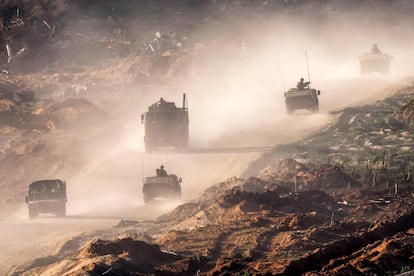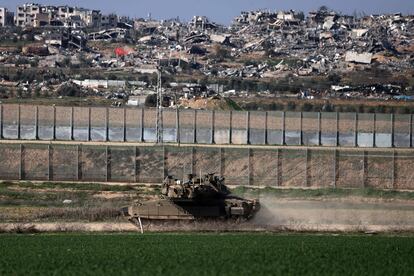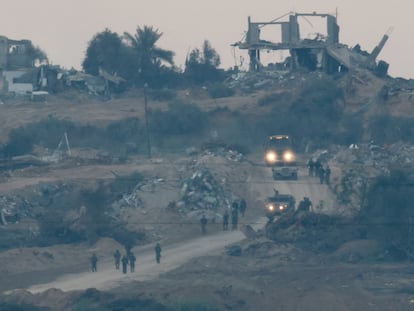Israel says Hamas armed wing ‘dismantled’ in northern Gaza as focus switches to ‘specific targets’ in the center and south
Benjamin Netanyahu insists the war will not stop until all hostages are freed and the Islamist military power is eradicated


While U.S. and European Union diplomatic chiefs are working to contain the spread of the Gaza war in the Middle East, Israel is sending mixed signals about the future of the conflict. Prime Minister Benjamin Netanyahu insisted Sunday at the start of the weekly government meeting, on the eve of the arrival in Israel of U.S. Secretary of State Antony Blinken, that “the war must not be stopped until we achieve all of its goals: eliminating Hamas, returning all of our hostages and ensuring that Gaza will never again constitute a threat to Israel. I say this to both our enemies and our friends.”
The army, however, has already declared the Izz ad-Din al-Qassam Brigades, the armed wing of Hamas, “dismantled” in its northern fiefdom in the Gaza Strip, while the Defense Ministry is advancing post-war plans and ordering the demobilization of tens of thousands of reservists called up three months ago. Israel Defense Forces (IDF) spokesman Rear Admiral Daniel Hagari announced Saturday night that Israeli troops had completely destroyed “the military structure” of Hamas in northern Gaza, where they have eliminated some 8,000 militiamen. “We are now focused on dismantling Hamas in the center of and south of the Gaza Strip,” he said, adding that the IDF would do so using a “different approach,” the details of which he did not specify. Hagari also did not specify the extent of the Hamas militia presence throughout the remainder of Gaza.
Defense Minister Yoav Gallant alluded Friday to “operations against specific targets,” as opposed to the massive bombardments of the northern section of the Gaza Strip over the past three months. In the Rafah pocket, on the border with Egypt, and the besieged refugee camp of Khan Younis in the south of Gaza, some two million civilians are crowded in inhumane conditions. Israel claims that Hamas’ military wing is hiding its top leadership in a network of tunnels that it says runs through both populated areas, forming “an underground city full of terrorists.”
Military intelligence sources quoted by the Israeli press admit that there are still groups of Hamas fighters in the north of the Palestinian enclave, although they now only act on their own, outside the organization’s chain of command, staging isolated ambushes and sabotage against Israeli forces. “At the moment, we are concentrating on the center and south of Gaza,” Hagari said, “on the basis of the lessons we have learned from the fighting so far.”
The international community, led by the U.S. and the EU, has called on Israel to minimize civilian casualties in its military operations. At least 113 people lost their lives in bombardments on Gaza Sunday, according to the records of the Ministry of Health in Gaza, which has been governed de facto by Hamas for 17 years. The total number of fatalities in Gaza after three months of hostilities is now close to 23,000, 70% of whom are women and minors.

At least two Palestinian journalists were killed Sunday in an Israeli attack, among them Hamza al-Dahdouh, the son of Wael al-Dahdouh, the Gaza delegate of the Al Jazeera television network, who lost part of his family in the Israeli bombardment. Mustafa Thuraya, who was accompanying him in a car near Rafah, was also killed, Gaza authorities said. The Qatar-based Al Jazeera network has accused the Israeli army of “deliberately targeting” Palestinian journalists in Gaza, most of whom were working with the international media, whose presence on the ground has been vetoed by the Israeli government since the beginning of the conflict. At least 110 journalists have been killed in Gaza since October 7, according to Palestinian sources, a figure that also includes intellectuals and internet news broadcasters. The Committee to Protect Journalists places the number of reporters killed in the Gaza Strip at 77.
In addition to reducing civilian casualties in the Palestinian enclave, international diplomacy is particularly concerned about the escalation between the Israeli army and the Hezbollah militia on the Lebanese border following the death of Hamas’ number two, Saleh al-Arouri, in an attack in Beirut. The exchange of fire reached its most intense level in three months of conflict on Saturday, when Hezbollah attacked a strategic air surveillance center in northern Galilee. The Israeli Air Force bombed positions held by the pro-Iranian group after intercepting a “hostile aircraft” that had entered Israeli airspace. The Lebanese Shiite militia confirmed that five of its fighters were killed by Israeli strikes on Saturday.
Senior U.S. administration officials have expressed concern about the possibility of Netanyahu extending the war to Lebanon for reasons of “political survival,” The Washington Post reported Sunday. These sources further noted that the U.S. Defense Intelligence Agency has warned that it will be difficult for the IDF to launch a successful incursion into Lebanon while its operations remain concentrated in the Gaza Strip. Thousands of Israelis, called to a protest by the families of the 139 hostages still held in Gaza, demanded the resignation of the prime minister on Saturday night in Tel Aviv.
Sign up for our weekly newsletter to get more English-language news coverage from EL PAÍS USA Edition
Tu suscripción se está usando en otro dispositivo
¿Quieres añadir otro usuario a tu suscripción?
Si continúas leyendo en este dispositivo, no se podrá leer en el otro.
FlechaTu suscripción se está usando en otro dispositivo y solo puedes acceder a EL PAÍS desde un dispositivo a la vez.
Si quieres compartir tu cuenta, cambia tu suscripción a la modalidad Premium, así podrás añadir otro usuario. Cada uno accederá con su propia cuenta de email, lo que os permitirá personalizar vuestra experiencia en EL PAÍS.
¿Tienes una suscripción de empresa? Accede aquí para contratar más cuentas.
En el caso de no saber quién está usando tu cuenta, te recomendamos cambiar tu contraseña aquí.
Si decides continuar compartiendo tu cuenta, este mensaje se mostrará en tu dispositivo y en el de la otra persona que está usando tu cuenta de forma indefinida, afectando a tu experiencia de lectura. Puedes consultar aquí los términos y condiciones de la suscripción digital.
More information
Archived In
Últimas noticias
‘I thought you would like it’: The risky sexual practice popularized by TV shows and TikTok
The digitalization of tourism: ‘They promise experiences and gave us the worst possible one’
Mexican peso defies uncertainty with forecasts of a new period of stability in 2026
Meghan Markle’s year of redemption: Numerous projects, some setbacks and a brand that is finally taking off
Most viewed
- Sinaloa Cartel war is taking its toll on Los Chapitos
- Oona Chaplin: ‘I told James Cameron that I was living in a treehouse and starting a permaculture project with a friend’
- Reinhard Genzel, Nobel laureate in physics: ‘One-minute videos will never give you the truth’
- Why the price of coffee has skyrocketed: from Brazilian plantations to specialty coffee houses
- Silver prices are going crazy: This is what’s fueling the rally










































